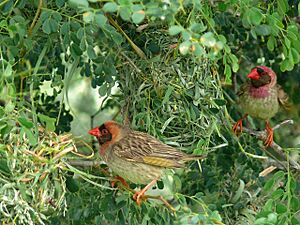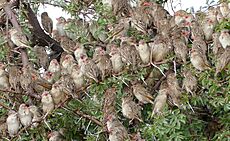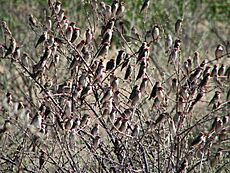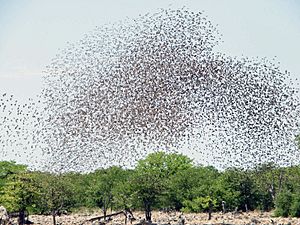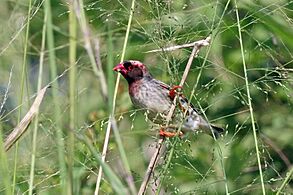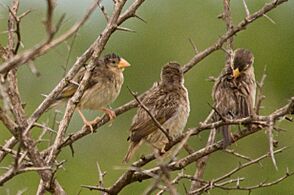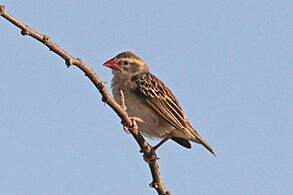Red-billed weaver facts for kids
Quick facts for kids Red-billed quelea |
|
|---|---|
 |
|
| Male breeding plumage of Q. q. lathamii | |
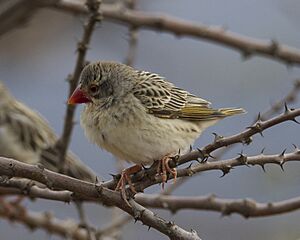 |
|
| Non-breeding plumage | |
| Conservation status | |
| Scientific classification | |
| Genus: |
Quelea
|
| Species: |
quelea
|
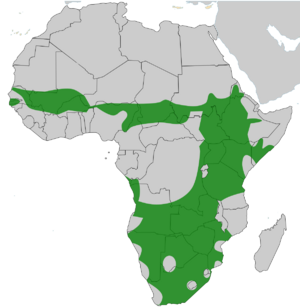 |
|
|
rough distribution
|
|
| Synonyms | |
|
|
The red-billed quelea (Quelea quelea) is a small, sparrow-like bird. It is about 12 centimeters (5 inches) long and weighs 15-26 grams (0.5-0.9 ounces). This bird belongs to the weaver family and lives in Sub-Saharan Africa.
It was named by Carl Linnaeus in 1758. Later, in 1850, Ludwig Reichenbach placed it in its own group, Quelea. There are three main types, or subspecies, of red-billed quelea. They live in different parts of Africa.
Red-billed queleas move around a lot to find food. They mostly eat seeds from wild grasses. But they can also cause a lot of damage to farm crops. Because of this, some people call them "Africa's feathered locust". They are thought to be the most common wild bird on Earth. Sometimes, there are as many as 1.5 billion of them after breeding season. They fly in huge groups, sometimes millions strong. When birds at the back run out of food, they fly to the front. This makes the flock look like a rolling cloud. The red-billed quelea is not in danger of disappearing. Its conservation status is listed as least concern.
Contents
About the Red-billed Quelea
The red-billed quelea is a small bird, about 12 cm (5 inches) long. It has a strong, cone-shaped beak. This beak is red in males and non-breeding females. During breeding season, females have a yellow or orange beak.
Most male queleas have a black mask on their face. This mask covers their forehead, cheeks, and upper throat. Sometimes, males have a white mask instead. The mask is surrounded by colors like yellow, rusty, pink, or purple. The rest of their body is light brown or whitish with dark stripes. Their wings and tail are dark brown. They have a narrow red ring around their brown eyes. Their legs are orange.
Outside the breeding season, males look different. Their heads are grey-brown with dark streaks. Their chin and throat are whitish. Their beak becomes pink or dull red, and their legs turn flesh-colored. Females look like non-breeding males.
Baby queleas are born with white beaks and very few feathers. Their eyes open around the fourth day. Young birds change their feathers a few times as they grow. By about five months old, they start to look like adult breeding birds.
Different Types of Quelea
There are three main types, or subspecies, of red-billed quelea. They are mostly different in how the male's breeding feathers look.
- The first type, Quelea quelea quelea, lives in West and Central Africa.
- The second type, Q. quelea lathamii, lives in Central and Southern Africa.
- The third type, Q. quelea aethiopica, lives in Eastern Africa.
Sometimes, these different types can breed together where their homes overlap. This means you might see birds that look like a mix of two types.
What Does a Quelea Sound Like?
When huge flocks of red-billed queleas fly, their many wing beats make a special sound. When they land at their resting or nesting spots, they make a lot of noise. This lasts for about half an hour before they settle down. Both male and female birds make calls. The male sings short songs. These songs start with chattering sounds and then turn into a warbling tweedle-toodle-tweedle.
Where Queleas Live
Red-billed queleas live in warm, dry areas of Sub-Saharan Africa. These areas have thorny grasslands, like the Sahel. They avoid thick forests, deserts, and very cold places. You can sometimes find them high up in mountains, but usually they stay below 1,500 meters (4,900 feet).
They visit farms to eat cereal crops. However, they prefer seeds from wild grasses. Queleas need to drink water every day. So, you will always find them within 30 kilometers (19 miles) of water. They also need bushes, reeds, or trees to build their nests and rest.
How Queleas Travel
Red-billed queleas travel long distances during different seasons. They follow the rain to find their main food source: grass seeds. The rain makes new grass seeds grow. Since rain patterns change across Africa, quelea populations move between different wet areas. Each subspecies tends to stay within its own set of regions.
For example, in Nigeria, queleas often fly 300-600 km (186-373 miles) south when the rains start in the north. This is because the grass seeds there start to sprout and are no longer good to eat. Later, they fly north again to find good places to breed.
Quelea Life and Habits
The red-billed quelea is considered the most common wild bird on Earth. Its total population can reach 1.5 billion birds after breeding. These birds are good at finding food. They specialize in eating seeds from annual grasses. These seeds are available at different times and places. So, queleas travel to make sure they always have food. They need to eat a lot of high-energy food to build up fat for their long migrations.
When they breed, they choose areas with thorny plants, like Acacia trees. These are usually below 1,000 meters (3,300 feet) high. When looking for food, they can fly 50-65 km (31-40 miles) each day. Then they return to their resting or nesting spot in the evening.
Small groups of red-billed queleas often mix with other weaver birds. They might also rest with other birds like barn swallows. In the wild, they usually live for two to three years. But one quelea lived for eighteen years in captivity.
Reproduction and Nesting
Red-billed queleas need a certain amount of rain to start breeding. They usually begin building nests four to nine weeks after the rains start. They build their nests in thorny trees, sugar cane fields, or reeds.
Their colonies can be huge, with millions of nests. There can be 30,000 nests in one hectare (12,000 per acre). More than 6,000 nests have been counted in a single tree! One colony in Zimbabwe was 20 km (12 miles) long and 1 km (0.6 miles) wide.
The male bird starts building the nest. He weaves strips of grass around a forked twig to make a ring. He uses his beak and feet to add more grass. A finished nest looks like a small, oval ball of grass. It's about 18 cm (7 inches) high and 16 cm (6 inches) wide. It has a small entrance, about 2.5 cm (1 inch) wide, high up on one side. About 600-700 fresh, green grass strips are used for each nest. These birds can nest several times a year if conditions are good.
Male queleas have different colored feathers during breeding season. These colors help them recognize each other. The brighter red on their beaks can show how strong or dominant a bird is. Male red-billed queleas mate with only one female during each breeding cycle.
Females usually lay three eggs, but sometimes one to five. The eggs are light blue or green, sometimes with dark spots. Both parents help to warm the eggs during the day. But only the female sits on the eggs at night. The eggs hatch in nine or ten days. After hatching, the chicks are fed protein-rich insects for a few days. Later, they mainly eat seeds. The young birds leave the nest after about two weeks. They can have their own babies when they are one year old.
What Queleas Eat
Huge groups of red-billed queleas usually eat on the ground. Birds at the back constantly fly over those in front to get to fresh seeds. This makes them look like a rolling cloud and helps them find food very well. They also eat seeds directly from grass plants. They prefer seeds that are 1-2 mm (0.04-0.08 inches) in size.
They mainly eat wild grass seeds. When these seeds run out, they eat seeds from farm crops. These crops include barley, sorghum, millet, rice, wheat, and oats. They also eat crushed corn from cattle farms. But whole corn kernels are too big for them to swallow. One bird can eat about 15 grams (0.5 ounces) of seeds each day.
Baby queleas eat a lot of insects, like grasshoppers, ants, beetles, and termites. They also eat snails and spiders. Adult queleas eat insects during breeding season. Females also eat snail shells and grit to help them make eggshells.
At sunrise, queleas form groups to find food. After finding a good spot, they settle down to eat. During the hottest part of the day, they rest in the shade, often near water. They also clean their feathers. Birds seem to like drinking water at least twice a day. In the evening, they fly off again to look for more food.
Who Eats Queleas?
Many animals hunt red-billed queleas. These include other birds like falcons and eagles. Snakes, warthogs, squirrels, monkeys, and mongooses also prey on them. Even big cats like lions and leopards might eat them.
Some birds, like the diederik cuckoo, lay their eggs in quelea nests. This means the cuckoo babies are raised by quelea parents. Snakes often raid nests to eat eggs and chicks.
Even crocodiles and turtles can attack queleas. Nile crocodiles have been seen hitting birds into the water with their tails to eat them. African helmeted turtles grab queleas from underwater when they come to drink. Some insects, like the armored bush cricket and scorpions, also kill and eat young queleas.
Queleas and Humans
People in many parts of Africa catch and eat red-billed queleas. Around Lake Chad, people use different ways to catch them. Some use special nets. An estimated 5 to 10 million queleas are caught near N'Djamena each year. This is a good source of food and income for local people. The birds are caught at night, cooked, and then sold in markets.
The impact of hunting on the huge quelea population is not very big. Queleas also help humans by eating pest insects, like locusts. Tourists enjoy watching the large flocks of queleas in places like the Kruger National Park. Because there are so many of them, the red-billed quelea is not considered an endangered species.
Keeping Queleas as Pets
Some people keep and breed red-billed queleas as pets. They do best in large, tall cages where they have space to fly. They are social birds and can live with other bird species. Keeping many queleas together is like their natural life in big flocks. They can handle cold weather but need shelter from rain and wind.
Pet queleas are usually fed tropical seeds and grass seeds. During breeding season, they get extra insects like mealworms or boiled egg. They also need grit and calcium sources like cuttlebone. If they have materials like fresh grass, they can build nests and breed in captivity.
Managing Quelea Populations
The red-billed quelea is sometimes called "Africa's feathered locust." This is because it can be a serious farm pest in Sub-Saharan Africa.
Governments in countries like Botswana, Ethiopia, and South Africa try to control quelea numbers. The most common way to kill large groups is by spraying a special chemical called fenthion from planes. This is done at night when the birds are sleeping in their breeding colonies or roosts. Some countries also use fire-bombs.
Early attempts to get rid of queleas completely failed. So now, the goal is to remove only the groups that are likely to attack farms. Organizations like the Desert Locust Control Organization for Eastern Africa help coordinate these efforts.
Gallery
-
Etching by George Edwards published in 1760
-
male Q. q. aethiopica in breeding plumage with pink wash, Uganda
-
male Q. q. aethiopica in breeding plumage with a yellow wash on the head, Uganda
-
Females in breeding plumage with yellow bills, South Africa
-
female Q. q. aethiopica in non-breeding plumage, Ethiopia



